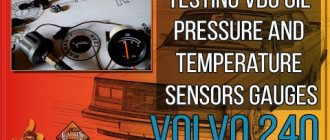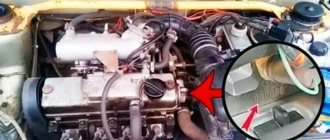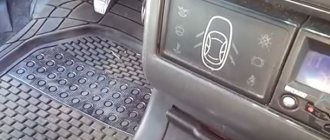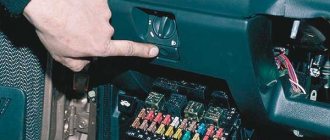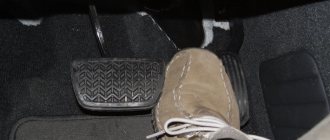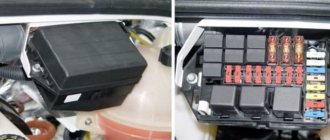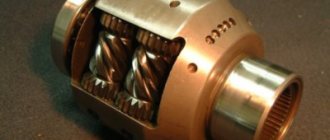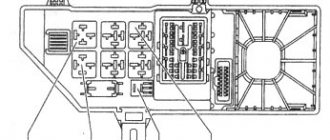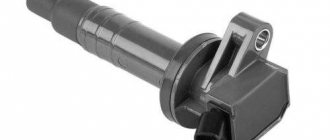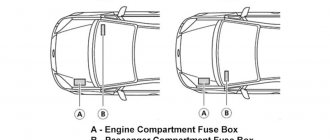Since the invention of the first internal combustion engine, engineers have had a very important goal - to extract maximum power from a specific volume of the power unit. Trying to solve this problem, designers conducted experiments with the number and layout of combustion chambers.
At various times, production car models used both small single-cylinder internal combustion engines and huge units with 16 cylinders. On different models, the combustion chambers are located and numbered differently, and this information will be very useful for a novice car enthusiast.
How are the cylinders located in engines?
There are different engine models - these include vintage one- and two-cylinder internal combustion engines, traditional in-line four- and six-cylinder models.
Related article: Signs, causes and consequences of car engine overheating
Larger units had V-shaped blocks - such units could have eight or more combustion chambers.
Row arrangement
With an in-line arrangement in the block, the cylinders are arranged in one row. In this configuration, there are two, three, four, five and even six-cylinder engines.
Two- and three-cylinder internal combustion engines are now installed on modern cars less often, although their popularity is slowly gaining momentum.
This was facilitated by smart fuel mixture preparation systems and turbines - for example, a turbocharged version of the two-cylinder internal combustion engine of the Fiat 500 hatchback. The three-cylinder in-line engine can be found on the Daewoo Matiz and many others.
As for the in-line “four”, such blocks are installed in most engines for passenger cars - the volumes of such engines start from 1 liter, and the largest in-line internal combustion engine is 2.4 liters. and more.
In-line five-cylinder engines began appearing in mass-produced cars in the 1970s. Among the first are Mercedes diesel models - they were installed in 1974 on the W123 model.
And already in 1976 they built a five-cylinder engine from Audi. Starting from the late 80s, the inline five no longer surprised anyone and was successfully installed on a variety of cars from Fiat, Volvo and other auto brands.
Tact
The movement of the piston inside the engine cylinders is called the duty cycle. The cycle consists of valve timing phases, which can be used to determine the moment of opening and closing of the valves. In a four-stroke vehicle, the full cycle occurs after turning the crankshaft by 720 degrees, in a two-stroke vehicle - by 360.
To provide the shaft with constant force during the power stroke in the engine cylinders, the knees of the unit are located at a certain angle relative to each other. The angle is affected by the number of cylinders, the type of installation and the location of the cylinders.
How to determine the operating order of internal combustion engine cylinders depending on the strokes.
| Half-turns of the crankshaft in the cylinders of a diesel and carburetor unit | Angle of rotation | Engine cylinder numbering | |||
| 1 | 2 | 3 | 4 | ||
| First | 0-180 | Exhaust gas release | Power stroke | Fuel and air intake | |
| Second | 180-360 | Fuel and air intake | Exhaust gas release | Compression of the air-fuel mixture | Working stroke |
| Third | 360-540 | Compression of the air-fuel mixture | Fuel and air intake | Working stroke | Exhaust gas release |
| Fourth | 540-720 | Working stroke | Compression of the air-fuel mixture | Exhaust gas release | Fuel and air intake |
Engine Tactics
The operation of engine cylinders consists of the following stages:
- Intake - the piston moves to bottom dead center, and the combustion chamber is filled with the air-fuel mixture through the intake valve. The exhaust valve is closed.
- Compression - both valves are closed, the piston moves to top dead center, compressing the fuel composition. Due to compression, the temperature in the chamber increases significantly, and the pressure in the engine cylinder also increases. An important parameter that affects the efficiency of a car is the compression ratio. The indicator means the ratio of the complete filling of the cartridges and the volume of the combustion chamber. For cars with a high octane number, high-octane fuel is required.
- The working stroke is when the valve is in the closed position, the mixture is ignited by the spark plug. Under the influence of pressure in the cylinder of the car engine during fuel combustion, the piston goes down, rotating the crankshaft. For efficient performance, it is necessary that the fuel burns completely before the piston reaches BDC. This is ensured by setting the ignition timing. In modern cars, adjustment is carried out by a built-in electronic unit. Older models are equipped with a mechanical regulator.
- Exhaust - the power stroke ends with the exhaust of exhaust gases from the engine cylinders. At this stage, an important process occurs - purging the engine cylinders. Purging of the engine cylinders is ensured by the simultaneous opening of the intake and exhaust valves. After the piston reaches TDC, the intake stroke begins.
Numbering of cylinders in different types of internal combustion engines
As for the standards for numbering combustion chambers, there are none. The way they are numbered in the internal combustion engine is influenced by the following factors:
- Type of drive;
- ICE type, block layout;
- Transverse or longitudinal arrangement of the unit under the hood;
- Side of rotation.
On standard front-wheel drive cars with a transversely mounted engine, the numbering begins on the timing side. So, near the timing belt there is the first cylinder and then all the others. The latter is located near the checkpoint.
Examples
In multi-cylinder V-twin engines, the first cylinder is located in the bank on the driver's side.
In American-made engines, the combustion chambers and their numbering may differ and defy logic.
So, for in-line fours and sixes, the first cylinder may be near the radiator, while on all other models the numbering begins towards the interior. If the numbering is reversed, then the cylinder closest to the passenger compartment is considered first.
Note: How to remove a hernia on a car wheel and why it is dangerous
The French are very original and use two methods of numbering the combustion chambers of internal combustion engines.
- On inline fours, the numbering starts from the flywheel.
- If it is a V-shaped six, then the row closest to the radiator is the first three cylinders, and the row closer to the passenger compartment is the last three.
Theory of internal combustion engine operation
The general principle of operation of engines running on gasoline or diesel fuel is known, perhaps, to everyone - fuel, burning in the cylinders, creates gas pressure that pushes the pistons, and then the force is converted into torque going to the wheels.
In order for the engine to operate evenly, fuel combustion does not occur in all cylinders at the same time, but in a certain order. The following are responsible for its compliance:
- gas distribution mechanism design;
- the angles between the cranks of the car crankshaft;
- cylinder arrangement - V-shaped or in-line;
- device of the ignition system for gasoline cars, and fuel injection pump for diesel cars.
How do V6 internal combustion engines work?
To ensure the efficiency of the operation of today's six-cylinder engines, it is also built according to a special system. The typical operating order of an inline 6 cylinder engine is the 1–5–3–6–2–4 method. In the form factor under consideration, the power unit is quite long and requires a large engine compartment.
To reduce dimensions, a “VE-like” system is sometimes used. Diagram of the operating order of the “pots” of 6 cylinder modern engines, V-shaped form factor – activation sequence 1-4-2-5-3-6.
Interesting: the six-cylinder design in question is considered one of the least balanced.
A unit from Audi, for which the specified operation order of a V-shaped six-cylinder automobile engine is relevant:
4 cylinder
There are both in-line and opposed four-cylinder engines, their crankshafts are made according to the same design, but the order of operation of the cylinders is different. This is due to the fact that the angle between pairs of crankpins is 180 degrees, that is, crankpins 1 and 4 are on opposite sides with crankpins 2 and 3.
1 and 4 necks on one side, 3 and 4 on the opposite.
In-line engines use the cylinder operating order 1-3-4-2 - this is the most common operating scheme, almost all cars work this way, from Zhiguli to Mercedes, gasoline and diesel. It operates sequentially with cylinders with crankshaft journals located on opposite sides. In this scheme, you can use the sequence 1-2-4-3, that is, swap the places of the cylinders whose necks are located on the same side. Used in 402 engine. But such a scheme is extremely rare; they will have a different sequence in the operation of the camshaft.
The boxer 4-cylinder engine has a different sequence: 1-4-2-3 or 1-3-2-4. The fact is that the pistons reach TDC simultaneously, both on one side and on the other. Such engines are most often found on Subaru (they have almost all boxer engines, except for some small cars for the domestic market).
Five-cylinder
These are units with 5 cylinders standing in a row. The relative displacement of the crankpins is 72 degrees. There are both two- and four-stroke samples; for the first (2 strokes), the standard order of optimal operation of the cylinder block for these engines is the activation sequence 1–2–4–3–5. This ensures uniform combustion of the fuel. These motors are widely used in marine technology.
On passenger cars, engineers report a different order for the operation of the “pots” of 5-cylinder typical engines - the 1-2-4-5-3 system.
How does the work cycle work?
The entire process of fuel injection, ignition, piston operation and exhaust gas emission is called the “work cycle”. Let's consider it using the example of a gasoline four-stroke internal combustion engine, standard for many passenger cars.
The cycle, as the name implies, is divided into four cycles of work:
In this state, the intake valve is open, the exhaust valve, on the contrary, is closed, the piston moves in the downward direction, and the prepared air-fuel mixture enters the cylinder.
All cylinder valves are closed, and the piston moves upward and compresses the previously injected mixture to the specified parameters.
The valves are still open and the mixture is ignited, producing gases. Their pressure begins to move the piston down, and the latter rotates the crankshaft.
At the end of the working stroke, the exhaust valve opens, the crankshaft moves the piston upward, and it displaces the exhaust gases into the exhaust manifold.
Interesting: a diesel engine has a different cycle. During intake, only air is sucked in, and fuel is injected through the injection pump after the air mass in the cylinder is compressed. When contacting air heated by compression, diesel fuel ignites.
To ensure stable and continuous operation, the fuel in the cylinders (sometimes called "pots") is ignited in a specific sequence. The order of operation of the engine must be observed to create a uniform action on the crankshaft.
Preparing the car
The machine being manipulated is placed on a flat surface. The driver's cabin reclines and locks. The upper part of the gas distribution mechanism is dismantled and the pump is turned off.
KamAZ 43118:
Devices:
- Keys: open-end for 13, ring for 14;
- Screwdrivers;
- Steel rod;
- Set of measuring plates.
Fixing the main chamber piston at the top
- Check the fixation force of the camera heads;
- Move the flywheel stop device down;
- Remove the flywheel housing protection plate;
- Insert the steel rod into the hole in the flywheel, turn clockwise until the product stops. Position – beginning of mixture injection (cylinder one).
Flywheel retainer, KamAZ engine:
Setting gaps
- Rotate the flywheel (2 holes – 60°, each 30°);
- Adjust the spacing of the first pair of cameras (1st and 5th). Using a 14 ring wrench, loosen the nuts
- adjusting screws. Use the 0.3 plate to adjust the intake valve, and the 0.4 plate to adjust the exhaust valve.
- Fix the nut, force 33-41 Nm.
- Adjust the spacing in chambers one through eight.
Setting up KamAZ 740, 6520, 5511 valves and other modifications:
- 180 degrees – 4th, 2nd;
- 180 degrees – 6th, 3rd;
- 180 degrees – 7th, 8th.
Adjusting clearances KamAZ:
Definition
Cylinder firing order is the sequence in which the cylinders fire alternately. Otherwise, we can call it a sequence of alternating expansion cycles. Factors influencing it: the number of cylinders, the nature of their arrangement, the design of the engine (in particular, the camshaft and crankshaft), as well as the interval between flashes. To be more precise, it is influenced by the location of the cylinders, crank journals and camshaft cams. The smooth operation of the engine, it is worth noting, depends, among other factors, on the sequence of strokes.
